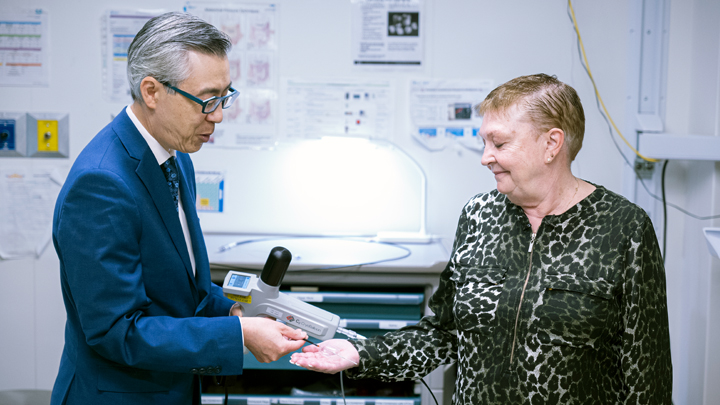
September 29, 2023

Dr. Clarence Wong, a gastroenterologist at the Royal Alexandra Hospital, shows Paulette Barry the balloon that was used through an endoscope to deliver liquid nitrogen to precancerous cells inside her esophagus. Photo credit: Photo by Evan Isbister.
Story by Sharman Hnatiuk | Photo by Evan Isbister
EDMONTON — Paulette Barry is the first person in Alberta to have liquid nitrogen used to freeze pre-cancerous cells in the tissue of her esophagus through a minimally invasive, non-surgical, day procedure she never second-guessed having.
“I trust Dr. (Clarence) Wong with my life,” says Barry. “He has taken such good care of me over the years to prevent my Barrett’s esophagus from progressing into cancer, I had no hesitation when we presented me with the new freezing treatment option.”
Barry developed Barrett’s esophagus due to long-term exposure to stomach acid, causing inflammation and damage to the cells that line the inside of her esophagus. Barrett's condition is one where the lining of the esophagus, the tube that carries food from the mouth to your stomach, becomes damaged.
“For advanced cases like Paulette, the current provincial protocol is to start with endoscopic radiofrequency ablation which uses heat to remove the damaged cells the esophagus, a treatment that was unsuccessful for Paulette,” says Dr. Wong, a gastroenterologist at the Royal Alexandra Hospital. “Thankfully, we now have another minimally invasive option that will help prevent the progression to cancer and help patients avoid more complex and painful surgeries.”
Last year, physicians from the Royal Alex in Edmonton and South Health Campus in Calgary travelled to John Hopkins in Baltimore, Maryland to learn how to perform endoscopic cryotherapy — a targeted freezing technique delivered inside the esophagus.
During Barrett’s procedure this past January, a thin, flexible tube with a special tool at the end (an endoscope) was inserted through the mouth using cold energy or cryotherapy to reach the affected area. There, nitrous oxide is delivered at -85 C to freeze the tissue. Within days, the dead tissue sloughs off and the esophagus heals. Patients undergo a follow-up examination three months later, at which time retreatment is performed for any residual areas of Barrett’s esophagus.
At Barry’s follow-up examination, retreatment to residual areas was successfully performed.
“After two cryogenic treatments we can see that Paulette is not only cancer-free, but she is also Barrett’s-free,” says Dr. Wong. “Her heartburn is gone; we’ve returned the lining of her esophagus to normal. We’ve essentially cured her of cancer before it even happened.”
Alberta is home to the only endoscopic cryotherapy ablation program in the country, something for which Barry says she’s thankful.
“Some people may think heartburn is just a minor inconvenience, but it can lead to serious health issues. Esophageal cancer took my dad’s life,” she says. “I’m so grateful this treatment option was available for me. I think it can save a lot of people’s lives.”